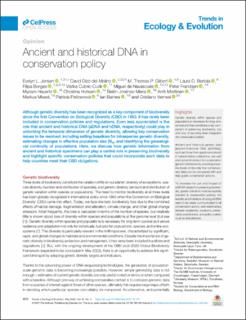| dc.contributor.author | Jensen, Evelyn L. | |
| dc.contributor.author | Díez-del-Molino, David | |
| dc.contributor.author | Gilbert, Marcus Thomas Pius | |
| dc.contributor.author | Bertola, Laura D. | |
| dc.contributor.author | Borges, Filipa | |
| dc.contributor.author | Cubric-Curik, Vlatka | |
| dc.contributor.author | de Navascués, Miguel | |
| dc.contributor.author | Frandsen, Peter | |
| dc.contributor.author | Heuertz, Myriam | |
| dc.contributor.author | Hvilsom, Christina | |
| dc.contributor.author | Jiménez-Mena, Belén | |
| dc.contributor.author | Miettinen, Antti | |
| dc.contributor.author | Moest, Markus | |
| dc.contributor.author | Pečnerová, Patrícia | |
| dc.contributor.author | Barnes, Ian | |
| dc.contributor.author | Vernesi, Cristiano | |
| dc.date.accessioned | 2023-11-27T08:11:20Z | |
| dc.date.available | 2023-11-27T08:11:20Z | |
| dc.date.created | 2022-04-25T11:21:27Z | |
| dc.date.issued | 2022 | |
| dc.identifier.citation | Trends in Ecology & Evolution. 2022, 37 (5), 420-429. | en_US |
| dc.identifier.issn | 0169-5347 | |
| dc.identifier.uri | https://hdl.handle.net/11250/3104689 | |
| dc.description.abstract | Although genetic diversity has been recognized as a key component of biodiversity since the first Convention on Biological Diversity (CBD) in 1993, it has rarely been included in conservation policies and regulations. Even less appreciated is the role that ancient and historical DNA (aDNA and hDNA, respectively) could play in unlocking the temporal dimension of genetic diversity, allowing key conservation issues to be resolved, including setting baselines for intraspecies genetic diversity, estimating changes in effective population size (Ne), and identifying the genealogical continuity of populations. Here, we discuss how genetic information from ancient and historical specimens can play a central role in preserving biodiversity and highlight specific conservation policies that could incorporate such data to help countries meet their CBD obligations. | en_US |
| dc.language.iso | eng | en_US |
| dc.publisher | Elsevier B. V. | en_US |
| dc.rights | Attribution-NonCommercial-NoDerivatives 4.0 Internasjonal | * |
| dc.rights.uri | http://creativecommons.org/licenses/by-nc-nd/4.0/deed.no | * |
| dc.title | Ancient and historical DNA in conservation policy | en_US |
| dc.title.alternative | Ancient and historical DNA in conservation policy | en_US |
| dc.type | Peer reviewed | en_US |
| dc.type | Journal article | en_US |
| dc.description.version | publishedVersion | en_US |
| dc.source.pagenumber | 420-429 | en_US |
| dc.source.volume | 37 | en_US |
| dc.source.journal | Trends in Ecology & Evolution | en_US |
| dc.source.issue | 5 | en_US |
| dc.identifier.doi | 10.1016/j.tree.2021.12.010 | |
| dc.identifier.cristin | 2018861 | |
| cristin.ispublished | true | |
| cristin.fulltext | original | |
| cristin.qualitycode | 1 | |

